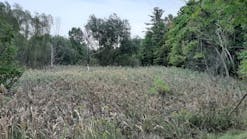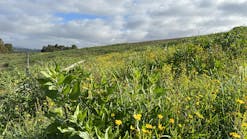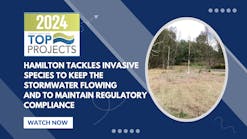The Boy Scout motto of “be prepared” has never been more applicable than now, as the stormwater Phase II rule of the National Pollution Discharge Elimination System (NPDES) Stormwater Program, published in USEPA’s Federal Register in November 1999, takes effect. A certain nervousness always accompanies new rules from EPA, but many operators and manufacturers have made impressive progress in preparation for this EPA-mandated regulation on stormwater management. These pioneers are ready and eager to tell us how it’s done.
“The more forward-thinking officials began to implement components of the Clean Water Act some time ago,” notes Debra Allard, president of KriStar Enterprises in Cotati, CA, a company whose products have been successful in preventing pollution in stormwater systems. “These communities have adopted stormwater pollution protection plans.” Those municipal officials who are just beginning to address the problems to be regulated this year will be glad to learn that good advice and good solutions are readily available from private and public sources.
Regulations and Definitions
During an interim Phase II in the summer of 1995, all nonregulated (non-Phase I) stormwater dischargers had to apply for NPDES permit coverage. The interim measure specified a deadline of August 2001, but new rules superseded it in October 1999. Those regulated will be the operators of small municipal separate storm sewer systems (MS4s) located in areas defined by the Bureau of the Census as “urbanized.” A small MS4 was not defined under the existing Phase I, nor was a specific population number mentioned, but it is generally considered to be a municipality of 50,000 or more. According to some estimates, Phase II will affect some 3,500 municipalities. The proposal also includes owners or operators of construction activities that affect as much as 1 ac. but less than 5 ac. of land. EPA estimates that up to 110,000 sites might fall into this category. The permitting authority for the NPDES stormwater program may also choose to include some small MS4s outside urbanized areas and some construction sites disturbing less than 1 ac. of land. The operators of those entities regulated under Phase II will be required to implement management controls for stormwater discharges and apply for the appropriate NPDES permit coverage. Best management practices should prevent or reduce the discharge of pollutants into receiving waters. For most of this year, the American Public Works Association and EPA have been holding workshops across the country, and EPA has a helpful Web site (www.epa.gov). Consulting engineers with relevant expertise have also declared themselves ready to assist both private and public authorities in preparation of the sites and with the necessary paperwork.
What are the actual sites that could be included in those municipal separate storm sewer systems? Coming under the regulations could be roads with drainage systems, catch basins, and the city streets (with their curbs and gutters collecting so much trash from both pedestrians and vehicles). Also affected are storm drains, ditches, and man-made channels. Some cities are already monitoring agricultural and commercial enterprises for runoffs that could, by their location, threaten the community’s health through uncontrolled pollutants deriving from their operations.
A newcomer to the program, under Phase II, is an MS4 owned by the United States; a federal facility such as a correctional institution or a military base. According to the proposal, regulated MS4 operators should have the ability to choose coverage under an individual permit, a general permit, or a modification of an existing Phase I MS4 individual permit.
What tools are available to help us achieve the necessary results? Key aspects of managing the stormwater are pumping, separation, and filtration. The pumping should manage the debris flowing with stormwater, and the filtration should keep unwanted particles out of the sewer system. A new product from KriStar is Flo-Gard, designed to help property owners come into compliance at an economical cost. This product incorporates the company’s original Fossil Filter concept (a catch-basin filtration system manufactured from plastic, fiberglass, or stainless steel). The newer version also contains a fabric filter body suspended from a permanently mounted metal frame, so that the fabric filter body is disposable. Allard states that more and more municipalities and specifying engineers are requiring proof of a maintenance contract for the equipment used. “Many excellent products, like oil/water separators, stormwater interceptors, and, yes, even our Fossil Filters have become expensive planter boxes because nobody required or performed maintenance.” The filtration systems are comparable to gutters on a house: They must be cleaned occasionally in order to function correctly.
Some of the product names are self-explanatory, some cleverly sophisticated. For keeping catch basins free of silt during construction, ACF Environmental in Richmond, VA, offers the Siltsack. Installation is quick and easy. Workers remove the drain grate, insert the Siltsack, and replace the grate to maintain the sack in position. During construction, the sack traps the silt. A frontloader or similar machine available at the site can remove the filled sack, which can then be cleaned for reuse or discarded. The Dirtbag, also marketed by ACF Environmental, has been successful in preventing silt from affecting streams, nearby property, and storm sewers. Taken to the site as a folded fabric bag, the Dirtbag proves useful when dirty water must be pumped from holes near construction sites (from foundations, perhaps), pipeline works, repairs for municipal and utility water/sewer lines, and utility and highway projects. “That’s easier than transporting straw bales,” remarks one general contractor whose truck availability and space are limited. The dirty water is then transferred into the bag from a 4-in. pump discharge via an integral spout. The bag collects the silt as the clean water filters out from all sides. This bag resists ultraviolet degradation and meets the specifications of the US Army Corps of Engineers, states, and municipalities. It comes in three standard sizes (up to 15 x 15 ft.), with custom sizes also available to suit a particular site.
StormTreat Systems of Sandwich, MA, has served to manage drainage problems. Its StormTreat system proved affordable and efficient when used at a site in Hingham, MA, headquarters for New England Sealcoating, which borders a wetland that is a tributary to a drinking-water source. When the Department of Environmental Protection ordered the storm drain to be stopped and the runoff kept at the site until a lasting solution was found, six StormTreat systems did the job well. At two other communities, Ipswich and Barnstable, in the same state, StormTreat systems have served to manage drainage from roads and parking lots, preventing pollution of receiving waters, such as the Ipswich River.
The Downstream Defender from H.I.L. Technology in Portland, ME, has been successful in capturing settleable solids, floatables, oil and grease from stormwater runoffs at such varied (NPDES Phase II-involved) sites as streets and roadways, parking lots, washdown yards for vehicle maintenance, construction sites, and industrial and commercial facilities and for wetlands protection. One practical feature of the Downstream Defender is its small footprint. “More versatile than conventional stormwater treatment systems, this product requires a fraction of the land area compared to storage tanks and detention ponds,” observes Pamela Deahl, P.E., vice president of H.I.L. Technology. After a storm event, the water level drains down to the invert of the outlet pipe, keeping the unit wet. “Maintaining a wet unit has two advantages,” she explains. “It keeps the oil and floatables stored on the water surface, separate from sediment stored below the vortex chamber, providing the option for separate oil disposal, if desired, by such methods as passive skimmers. The maintenance of a wet unit also prevents stored sediment from solidifying in the base of the unit. If a system allows fine sediment to dry out and consolidate, the cleanout procedure becomes more difficult, usually meaning that cleanout crews must enter the chamber and manually remove the sediment. Such a procedure can be a labor-intensive operation in a hazardous environment.”
Even in the same community, problems of flow and substance can vary widely. Hydro-Kleen in Carson City, NV, offers equipment that can be customized to remove site-specific substances. There are six sizes of the Hydro-Kleen HK-200, a standard model for paved surfaces without much sediment entering the storm drain. For sites with a heavier load of sediment, the Model SC-100 deals with the sediment and such floatable debris as cigarette butts, leaves, and pine needles. Installation of the equipment can be adapted to different designs of storm drain and grate frames. The Hydro-Kleen uses two or more filter media to widen the range of contaminants that the system can remove. According to the manufacturer, benefits include efficiency in all temperatures, including those below freezing; rapid-flow operation; and locking absorbed materials into fibers to prevent leaching from the primary medium.
Those involved in municipal budgeting are aware that a growing percentage of a city’s annual budget must be allotted for compliance with unfunded federal mandates. “Unfunded” is the key word. Put simply and bluntly, it means that a federal mandate tells a municipality that it has to do something, but provides no funds to implement the requirement. Thousands of municipalities and counties have seen this situation play havoc with their annual budgets. The Clean Water Act is estimated to be the most expensive federal mandate for local authorities, with the Safe Drinking Water Act not far behind. One of the most important aspects of the NPDES Phase II event is the education of the public about the importance of its concept and content. If the funding is not readily available in their community, the residents know that something else-a program they might have enjoyed for years-is in jeopardy. It could mean cuts in health services, the public library, or street-clearing operations. Some cities have generated funds to help pay the costs of proposed stormwater management systems by charging fees to property owners according to the permeability of their properties. But that method of funding has been challenged in court and disallowed on the basis that the fee was really a new tax that required public approval by a vote. Rulings in the best-known case, Bolt v. Lansing (MI), will certainly affect future funding nationwide. The public, then, needs to be aware of its communities’ problems and supportive of the authorities.
David Woelkers of Hydro Compliance Management in Whitmore Lake, MI, distributor of Hydro-Kleen products, stresses the importance of cooperation between manufacturers and municipalities, urging the sharing of expertise and experiences. “Everybody involved needs to be educated. That includes municipal officials, state officials, manufacturers, and distributors like ourselves. The costs involved in remediation and prevention reflect the seriousness of the problems, and we should all ensure that time, money, and effort expended by all people concerned are well spent and productive for both the short and long term.”
To improve public education concerning NPDES, some communities mark stormwater inlets with “No Dumping” messages. “There are two benefits from this,” observes Don Sommer at das Manufacturing in Valrico, FL, a company that produces a variety of markers. “The message on each inlet alerts the public that materials like motor oil, grass clippings, and cigarette butts dumped into the inlet will drain directly into local waterways. Also, when volunteers from the community mark the inlets, they realize firsthand the consequences of dumping and become more protective of their community’s waterways.” Sommer recommends markers from das Manufacturing rather than traditional signs stenciled in paint because they remain aesthetically pleasing and do not fade. Sloppy, smeared messages in paint hardly impress the public as important, yet it is essential that the public see stormwater management as important. Another feature of das’ curb markers is that the “No Dumping” sign explains that the drain flows to a stream, the ocean, a creek, a river, a bay, or a lake. The explanation seems to involve the residents and visitors more personally and persuades them to participate in the management of precious resources.
It pays to research all the advantages (and possible disadvantages) of different methods for stormwater management control. One of the goals in pumping stormwater is to move the greatest possible amount of water, but inevitably the water will contain debris and sticks. Axial flow pumps move lots of water, but their output weakens dramatically when the head is greater than anticipated, and they do not handle debris well. At Winnetka, IL, the Department of Public Works chose SRS Crisafulli (Glendive, MT) pumps for stormwater management. One of the 16-in. pumps, capable of moving 10,000 gpm at 10 ft. of head, offers a choice of electric power or power take-off (PTO). Electric power is cheaper than PTO power, but the PTO option is a savior when the electricity is unavailable, as may well happen during and after storms and flooding. The fabricated Crisafulli pumps have handled the debris well at the Winnetka site, costing about half what the replaced axial flow pumps had cost. These pumps can be installed in permanent positions or can be transported behind a pickup truck or other vehicle on their own wheeled, highway-safe frames. The Army Corps of Engineers has specified and used hundreds of Crisafulli pumps for flood control in many states; their portability and ability to handle debris with the water seem suited to the (sometimes unpredictable) behavior of stormwater in natural disasters.
Traditional methods to keep sediment from going down into a curb inlet or storm drain have included gravel, geosynthetics, and straw bales, but too frequently these barriers have been unable to let the water percolate through them fast enough. In the March 1999 issue of Erosion Control, Greg Northcutt’s article on “Ideas and Technologies to Improve Your Sediment Control Success” points out that, under those circumstances, the water may just run down the street to a low spot or a sump where it can form a pond or cause flooding. Straw bales straight from the field are not state-of-the-art. Operators should find as much technical information as they can about different kinds of barriers for storm drains, and consider all the aspects of any proposed system. Generally speaking, municipalities need to find a system to remove floatables and solids (and prevent the solids from polluting their receiving waters), but they do not want to incur the labor expense of constant monitoring nor to rebuild much of their existing infrastructure. There are many screens available, each offering a particular feature or benefit-probably a proprietary method of cleaning or a technique for disposal of the solids collected.
Straw Wattles have some advantages over straw bales. Produced by California Straw Works in Sacramento, CA, the wattles have been successful in fighting land erosion in vineyards, forest-fire areas, ski slopes, and road cut slopes, but for NPDES applications, they can be snaked or curved completely around storm drains, drop inlets, or stock piles. “The wattles work best on soil where they can be trenched and staked,” says Sherryn Haynes of California Straw Works. “Workers have found that if they lay the wattles along the sidewalk or curb before backfilling, then backfill against the wattle, they will already be in a trench and will be held firmly enough against the curb so that staking is not needed. This makes it easier to drive over them and easier to pick them up for reuse. The sediment stays on-site, off the asphalt, and out of the storm drains.” When used on slopes, they can help prevent the development of rill and gully erosion, protecting lakes, streams, and storm drains below the slope. Because these wattles tend to pond water behind them, they can be angled to divert runoff away from roads. Haynes cautions that Straw Wattles are not intended for high flows, but they are most suitable for low-flow areas, including many construction sites.
“A lot of anxiety about these problems addressed by NPDES Phase II would be prevented if people were prepared for the erosion problems that are bound to happen,” observes Haynes. She praises the work done by local agencies and groups in California, where workshops comprising classroom talks in the morning and field demonstrations in the afternoon have shown developers and contractors how problems start and what to do about them. “Many of the people affected by NPDES are apprehensive, usually because they don’t know what to do or how to do it,” she says, echoing the thoughts of many with whom we spoke. “Many will not spend the money for sediment control unless they are forced to, but all it takes is one or two companies being slapped with a heavy fine, and suddenly others sit up and take notice.” The money derived from fines is used to help put on the workshops. The field demonstrations, sometimes scheduled for a site where little or nothing has been done to manage sediment control, are excellent opportunities for concerned parties to see the problems and to evaluate the solutions offered by different types of products from vendors that participate in the programs.
CSR Hydro Conduit offers three types of StormceptorSystem: the In-Line, Inlet and Submerged designs. Use of ground space is again an important aspect of these products. The vertically oriented Stormceptor requires only a small space, and that canbe in a new or existing storm drain, says the manufacturer. There is little disturbance of existing utilities. The Stormceptor, made of precast concrete, arrives at the site in easy-to-assemble components. “After the appropriate excavation, installation takes less than half a day,” says Neil Atkinson, marketing manager for CSR in Kansas City, MO. “A further advantage is that it is readily inspected from the surface. Routine maintenance and cleaning is normally an annual task, performed from the surface by a vacuum truck.” With this system, during infrequent high flow events, peak stormwater flows will pass over the diverting weir and continue through the bypass chamber into the downstream stormwater system. This bypass activity creates pressure equalization across the bypass chamber, preventing scouring. Some incoming sediment continues to be diverted by the weir into the lower chamber, where it is stored with previously collected sediment and hydrocarbons.
Some states seem to be ahead of others in their programs. Michigan, California, and Maryland spring to mind, but this is not a situation in which one state or municipality is trying to prove any superiority over others. We perceive that the people involved in NPDES Phase II, at public agencies and representing manufacturers, were all seriously committed to solving the problems of stormwater and willing to share their experience and expertise with others. It is gratifying that such people are involved in solving what is a national, potentially catastrophic problem.





